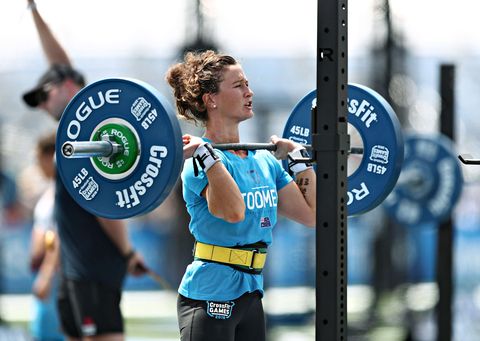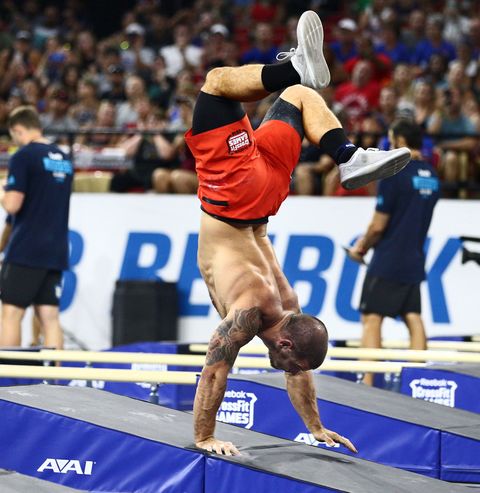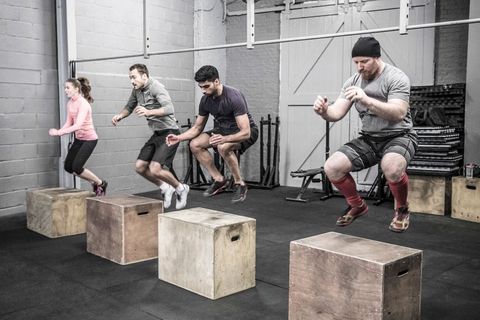
Greg Glassman is a numbers guy. For that he thanks his father, a rocket scientist for Hughes Aircraft who was “always up my ass about science, data, and what science is and isn’t,” says Glassman, 62. Fitness, fatness, fraudulence, and what a stupendous mess the American health system is—they’re all just numbers and data sets, equations you can solve with a lot of sweat; a few knock-down, drag-outs; and big, disruptive ideas.
20,000
“There are at least 20,000 of you training in CrossFit boxes,” says Glassman, addressing 40 doctors inside an 8,000-square-foot barn nestled in central California’s farm country. It’s a diverse group—a neurologist from Boston, a trauma surgeon from San Francisco, an orthopedic surgeon from Jackson, Mississippi. Glassman is wearing jeans, graphic T-shirt, and backwards camouflage hat—that California-casual getup he rocks whether he’s on 60 Minutes,lecturing at Harvard, or meeting with politicans.
“Can we all agree something’s wrong with the health system?” he asks. The doctors lean in, sucked into the Glassman vortex. “Show of hands.” Every doc reaches skyward. “You’ve seen things about health that are essential and true, and when your lying eyes are at odds with your medical training, you need to rethink your education,” he explains, methodically pacing with a mild limp, the result of childhood polio and bone-breaking dismounts as a high school and college gymnast. “That’s why I’m here.”
“Here” is CrossFit Holy Land: “the Ranch” in Aromas, the site in 2007 of the first CrossFit Games, a weekend when 400-plus stupid-fit people do stupid-hard workouts to determine the fittest humans on earth. Glassman invited the doctors here to indoctrinate them with a CrossFit MDL1 course, a certification reserved for M.D.’s. There’s a 400-doctor waiting list for future courses.
Across more than 20,000 hours of medical school, physicians receive about 25 hours of lecture on nutrition. As for exercise? LOL. What really digs at Glassman is that docs do, however, spend semesters on pharmacology. “The CDC estimates chronic diseases [and mental-health conditions] account for 86 percent of health-care spending and 70 percent of deaths,” he says. “If people would just get off the couch and off the processed carbs, 40 percent of those deaths could be avoided.”
Enter CrossFit Health, Glassman’s shotgun blast at America’s obesity crisis: It’s a steady stream of these MDL1 courses, which will create a network of CrossFit-friendly doctors who might prefer to prevent and fix couch-and-carb-induced lifestyle diseases by sending you to a box instead of a pharmacy or a surgeon. It’s the brand’s attempt to huddle the overweight, diabetic masses. On Instagram, CrossFit posts fewer images of jacked 20-somethings doing reps to infinity and more shots of what CrossFit does for people you might see at Walmart: a diabetic woman doing her first box jump, an 80-year-old lifting a dumbbell from the floor, a daily flow of before-and-after weight-loss shots.

Getty Images/Pekic
CrossFit Health is about increasing the number of CrossFit boxes, creating access for all. It’s also about fighting the establishment: lawsuits against fitness organizations trying to bring down the brand as well as junk-food companies that fund nutrition science. Hell, it may eventually be a health-care association and insurance package for the 4 million CrossFitters. It is seemingly many things, all of which are evolving organically, exactly how Glassman likes. “It would be a mistake to engineer this from the top down,” he says.
A doctor interjects, “What do we say if our patients have seen the Games and say ‘That’s not for me’?”
“Invite them to the gym,” says Glassman. “For each athlete who’s gone to the Games, we have 15 people who’ve used CrossFit to lose 100 pounds or cure their diabetes.”
“What about concerns that they’ll get injured?” asks an orthopedist.
That i-word pulls the trigger. “Jesus, as a vast discipline, you orthopedists can’t get enough of football and running, but somehow CrossFit is the boogeyman,” Glassman says. “Fuck injuries. You think we got to 15,000 boxes by hurting everyone?”
“No, not me,” the orthopedist says. “I’m asking for other doctors. . . .”
“Yeah, I get that,” says Glassman. “But see, we gotta unfuck the doctors first.” The most controversial man in fitness is at it again, picking fights with the establishment.
“Fuck injuries. You think we got to 15,000 boxes by hurting everyone?”
21-15-9
An hour before Glassman’s speech, the M.D.’s did an eight-minute workout
of 20 medicine-ball cleans and situps done AMRAP-style: as many rounds as possible. Each doc was equally gassed afterwards. Fast, hard, short workouts like this started it all.
In the ’70s, Glassman, a high school gymnast and avid cyclist despite his polio, began developing a radical physical practice in his parents’ San Fernando Valley garage. With a Sears weight set and a doorframe pullup bar, “I did 21 front squats to overhead presses followed by 21 pullups. Then I immediately did 15, then 9,” Glassman says. “In just three minutes, I had that nasty, vomitus feeling you have after a competitive gymnastics routine. I couldn’t get that from bodybuilding. I’ll never forget that lesson.” Which was this: Doing basic human movements at a high intensity will get you really, really fit. The descending-rep scheme ensured that he could maintain intensity throughout.
Glassman, who says he was the “Albert Einstein of recess,” dropped out of college and pursued his passion for movement. He started training clients in Los Angeles’s gyms, which favored bodybuilding: muscle-isolating exercises, typically using machines on (insert the body part) days. “I’d have clients at Gold’s Gym do things like five-minute rounds of pullups, back squats, bench press, and bike sprints,” he says. The method was fast and loud. It monopolized equipment. Its followers breathed heavy and sweat hard. But it worked, and soon people were bailing on other trainers to work with Coach Greg. And because he rarely meets a confrontation that doesn’t tickle him, “I got thrown out of a lot of gyms,” he says.
After moving to Santa Cruz and getting fired from the last gym in town, Glassman, with his then-wife, Lauren Jenai, opened his own spot in 2001: CrossFit, a catchy name for a storage unit filled with equipment like climbing ropes, bicycles, rowing machines, and barbells. He then started posting his far-out workouts of the day (WODs) to CrossFit.com. “It was like a SETI experiment where scientists send a signal of the number pi, 3.14159265, out into the universe,” he says. “If you hear back, it means there’s intelligent life out there. We heard back.” Glassman’s rule: Intensity and results are directly proportional. He says this isn’t masochism for masochism’s sake. “It’s physics.” His equation: You’re fitter when you can do equal or more work faster.

Courtesy CrossFit Inc
2.1 per 1,000
Soon a couple of guys in Seattle who followed Glassman’s online WODs asked if they could open a CrossFit affiliate. “I said, ‘What the fuck’s an affiliate?’ ” Glassman says. “They said ‘We’re going to use your name and do what you’re doing.’ So I said, ‘Okay, I’ll charge you $500 and then I’ll waive your fee.’ And that’s what we did.”
By 2005, the brand had a small but rabid online following and the number of CrossFit gyms had jumped from 15 to 50. The method proved especially popular among police, firefighters, soldiers, MMA fighters, professional athletes, and other “overachievers.”
CrossFit hit 500 affiliates by 2009, the boxes now drawing a wider crowd who loved the camaraderie, hard workouts, and ensuing results—with each new CrossFitter becoming a walking, talking billboard who’d love to tell you anything and everything about their CrossFit workout, CrossFit friends, and CrossFit diet.
With the manic intensity and people pushing beyond their limits came concerns of injury. CrossFit’s embrace of unofficial mascots like Pukie the Clown and Uncle Rhabdo (which, if you know Glassman, are more provocative than prescriptive) fed the hype. These peaked in 2013 when Ohio State University researchers released a highly publicized study in the scientific publication of the National Strength and Conditioning Association—a governing body of fitness—that “call(ed) into question the risk-benefit ratio” of CrossFit, which the authors labeled “extreme.”
Glassman’s team investigated and discovered “fraudulent data” in the story. They sued the NSCA and accused it of producing “unscientific manufactured hit piece(s)” engineered to injure CrossFit’s business. The claims at first seemed conspiratorial, but the evidence revealed the truth: CrossFit won the suit, the study was retracted for shoddy science, its author and editor stepped down, and the judge accused the NSCA of perjury and concealing evidence.
Given CrossFit’s popularity and the injury question, there’s been no shortage of additional study on the topic. Most of the research suggests that CrossFit is not more dangerous than other strength-based training and safer than many endurance sports, like running. Researchers in the UK found that CrossFit results in roughly 2.1 injuries per 1,000 training hours. The figure for recreational running is eight; for novice runners, 18.

Getty Images/Pekic
“CrossFit for competition has a different goal than CrossFit for general fitness,” says Doug Kechijian, P.T., a New York City–based trainer. In competition, you go all out with fixed exercises and weights. CrossFit for general fitness scales workouts to your ability. For example, if the workout calls for a handful of 95-pound barbell snatches and your form is shaky, you might reduce the load, drop the reps, or swap in a similar but less technical exercise.
10
What’s fit? For powerlifters it’s picking up heavy stuff. For runners it’s quickly covering ground. For Glassman, fitness revolves around the skills humans have needed to hunt and gather for 2 million years. He identified ten in The CrossFit Journal in 2002: endurance, strength, stamina, flexibility, power, speed, coordination, agility, balance, and accuracy. Glassman’s back-to-the-future fitness meant being ready for anything.
He condensed his thinking in his 100-word definition of fitness: “Practice and train major lifts: deadlift, clean, squat, presses, C&J, and snatch. Similarly, master the basics of gymnastics: pullups, dips, rope climb, pushups, situps, presses to handstand, pirouettes, flips, splits, and holds. Bike, run, swim, row, etc., hard and fast. Five or six days per week. Mix these elements in as many combinations and patterns as creativity will allow. Routine is the enemy. Keep workouts short and intense. Regularly learn and play new sports.”
The varied, intense training appeals to first responders. “CrossFit absolutely contributes to building better military units,” says Virginia congressman and retired Navy SEAL Scott Taylor. “People improve their strength, endurance, flexibility, movement—and can do more things that carry over to the job.”
Beyond escaping boredom, these diverse external stimuli fill your fitness gaps and lead to more beneficial internal adaptations, says Kechijian. A long endurance session, for example, expands the chambers of your heart, while all-out weight intervals increase the strength of its contractions. The combination helps you better fend off heart disease.
520 and 5:20
Just beyond the barn rises a steep, grassy cow-and-turkey-populated hill bisected by a dirt four-wheeler trail. It’s the Hamburger Hill of the CrossFit world. Many an early CrossFit Games tasked athletes with repeatedly running up, down, and around it. Athletes would then head to the barn area for Olympic lifts.
The event in just a few years outgrew the Ranch and moved to L. A.’s StubHub Center, and eventually to Alliant Energy Center in Madison, Wisconsin. The Games are open to all CrossFitters, with qualifiers held over six months and the 400 top athletes going to the five-day finals.
Mat Fraser, three-time winner of the CrossFit Games, can deadlift 520, run a mile in 5:20, and row a marathon in 2:48:36. Alone, these feats are not world-class. But their convergence is freaky, the human equivalent of a sedan that can tow a tank, compete in a drag race, and get 60 miles to the gallon. “The Games athletes are doing things that no one thought was possible ten years ago,” says Chris Spealler, who has competed in seven Games.
The event is a hothouse for fitness creativity, and Dave Castro, a retired Navy SEAL and CrossFit’s Games manager, is its Picasso. He devises physical tests inspired by art, mathematics, psychology, and sports, among other disciplines. He recently set rep schemes based on the Fibonacci sequence, a series of integers seen in complex mathematics and the threads that make the fabric of the universe: the forming of pinecones, storms, galaxies—and merciless workouts. A recent hit includes that row marathon. “I wanted something that tested them mentally . . . doing the same difficult thing for hours,” says Castro.
There are now thousands of different WODs, the most famous of which are Glassman’s “girls”—Fran, Cindy, and Diane—benchmark workouts he says he developed to measure progress: “Any workout that leaves you flat on your back, staring up at the sky, wondering what the hell happened deserves a girl’s name.”

Courtesy CrossFit Inc
26%
During a training session, the doctors circle a set of gymnastics rings hanging from the barn’s 20-foot ceiling. One grabs the rings and hangs. She quickly pulls herself up, bringing her body in toward the rings, begins to press, then stalls and plummets back to a hang. She’s attempting her first muscleup, a technical gymnastic exercise that combines a pullup and dip.
Someone offers a form tip: “Bring your elbows and hands in close to your torso.” Attempt two: Her chest rises toward her hands; she leans in, keeping her hands tight into her shoulders, then presses. Her body slowly rises above the rings.
Might as well have been the savior rising once more. The docs lose their shit, yelling, clapping, and whistling.
Nearly half of Americans report feeling lonely, according to research from Cigna. Scientists at Brigham Young discovered that lonely people were 26 percent more likely to die across seven years, making social isolation as bad for you as obesity.
Picture a traditional gym. Everyone has earbuds in, avoids eye contact, and scrolls through their phone between sets. Now picture a CrossFit box. It’s the scene with the doctors times 15,000. A group of 10, 15, up to 50 people exercise together. They encourage each other through the same workout, personal bests are posted on a whiteboard, no earbuds in or cell phones out. “CrossFit moved strength training from an isolated experience to a communal one,” says Casper ter Kuile, a researcher at the Harvard Divinity School who has studied CrossFit.
Yes, that holds you accountable to show up and work hard, says ter Kuile. But he’s more concerned with the deeper impact. “In a time of increased isolation and declining traditional religious congregations, our research found that CrossFit boxes are places where people can find meaning and belonging,” he says. “The community helps each other work towards self-transformation.”
1:2
Half of Americans have at least one chronic disease, and more than a million people die unnecessarily each year from the maladies.
“All this mess is rooted in excessive carb intake and a lack of movement. It’s sugar,” says Glassman, diving down the rabbit hole, a place he frequents. He began developing his nutrition ideas in the ’90s while working at a Gold’s Gym in Venice alongside a trainer who “was getting people skinny inordinately fast,” he says. “One day she pulled me aside and told me she was having clients restrict their carbohydrates.” From there he met Barry Sears, Ph.D., a former MIT researcher and creator of the Zone Diet. These encounters gave rise to CrossFit’s suggested 40/30/30 split of macronutrients among carbs, fat, and protein. The paleo thing? It caught fire when Robb Wolf, a nutrition scientist, began talking about the diet in early CrossFit nutrition seminars.

Getty Images/JohnnyGreig
Go ahead, exercise as hard as you can. If you stuff your face like an unsupervised eight-year-old, “you only have one oar in the water,” says Glassman. “Eat meat and vegetables, nuts and seeds, some fruit, little starch, no sugar. Keep to levels that will support exercise but not body fat.” That’s the rest of “Fitness in 100 Words.”
It’s sound nutrition advice. Most research suggests that carbohydrates—especially from whole-food sources—aren’t inherently fattening. And nutritionists generally agree that added sugar is a scourge. The eating plan is reinforced in boxes and is approachable for any diet novice. “Most diabetic patients usually eat way too many processed carbohydrates, especially sugar,” says Tom Siskron IV, M.D., a Louisiana-based physician who also comanages CrossFit Medicus One. Glassman’s framework eliminates the garbage and directs people into nutrient-dense, natural, filling foods. “Some of my patients have been able to get off diabetes and blood-pressure medicine following the advice,” says Dr. Siskron. Research shows that exercise and eliminating processed carbohydrates from your diet can reverse diabetes—the key is adhering to the program. CrossFit’s simple eating plan, scaleable fun workouts, and built-in community may make it that much easier.
“Eat meat and vegetables, nuts and seeds, some fruit, little starch, no sugar.”
8x
“Ay, ay, ay, ay. Canta y no llores.” A mariachi tenor backed by a traditional Guadalajaran band belts lyrics into the salty evening air. The seminar is over, and a backyard gathering at Glassman’s home overlooking Monterey Bay is lit. There are doctors of all specialties, CrossFit execs and Games athletes, Special Forces operators, scientists, a drooly 150-pound mastiff, and, yeah, the mariachi band.
Glassman pivots from group to group, attracting attention. He is in conversation like a pit bull on a pork chop. His eyes gloss and his laser of consciousness is equal parts erudite, poetic, and conspiratorial.“These scientific organizations are funded by soda proxies,” he says. “Their campaigns to produce junk science are successful to the extent that they can impact the margins and create fear around thinking outside the establishment.” Turns out Big Soda may have been Glassman’s nemesis all along.
During Glassman’s legal fight with the NSCA, his team discovered that the association’s research was funded partly by the soda industry. More digging revealed other health organizations cashing Big Soda’s checks. Scientists at Boston University confirmed 96 of them, and other research shows that studies funded exclusively by food and drink companies are four to eight times as likely to find results positive to the funder. In one case, for example, Coca-Cola secretly bankrolled the now-disbanded Global Energy Balance Network, a university-based nonprofit whose basic message was that what you eat doesn’t matter so long as you exercise enough—junk science. Drinking one or two sugar-sweetened beverages a day, for example, is associated with a 26 percent increase in risk of type 2 diabetes, say Harvard researchers.
“It was the Big Soda stuff that compelled Greg to start CrossFit Health,” says Pat Sherwood, a former Navy SEAL who works for CrossFit. “But if someone can take it on, it’s that guy. Greg likes to fight, and he never, ever backs down.” Glassman sees science sponsored by pop as akin to Big Tobacco’s paying for bad research to cast doubt on the harms of smoking. He regularly calls out publicly the names of researchers who have accepted soda dollars and is lobbying to strengthen conflict-of-interest guidelines at the CDC and the National Institutes of Health. He backed a failed California bill to add warning labels to soda, but he’s continuing that fight.
“The real, less sexy story of CrossFit is the unseen epidemiological revolution that has millions of CrossFitters taking a pass on chronic disease,” says Glassman. “If you eat too much sugar and you can’t squat, pick up things off the ground, throw, jump, run, and climb, then you’re broken. And we want to fix you.”
Source: Read Full Article